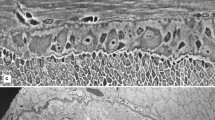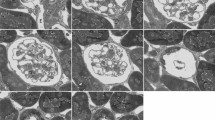Summary
The differentiated cytology, cytochemistry, and functions within subdivisions of the tuber cinereum prompted this morphometric and physiological investigation of capillaries in the median eminence and arcuate nucleus of albino rats. Morphometric studies established that the external zone of the median eminence had 3–5 times the number and surface area of true and sinusoidal capillaries than the internal or subependymal median eminence zones, or either of two subdivisions examined in the arcuate nucleus. Type-I true capillaries, around which Virchow-Robin spaces comprise 1% of arcuate tissue area, were situated proximally to the median eminence border. This finding is consistent with a premise that confluent pericapillary spaces enable infiltration of arcuate neurons by factors from capillary blood from the median eminence or Virchow-Robin spaces. Physiologically, the rate of penetration across the median eminence capillaries by blood-borne [14C]α-aminoisobutyric acid (a neutral amino acid used as a capillary permeability tracer) was 142 times greater than for capillaries in the distal arcuate nucleus within 12 s of tracer administration. A new finding was that the proximal arcuate nucleus had a permeability x surface area product of 69 μl g−1 min−1, 34 times greater than that in more distal aspects of the tuber where blood-brain barrier properties exist. We also found that the microcirculatory transit time of a plasma space marker, [14C]sucrose, was considerably longer (1.2 s) in the median eminence and proximal arcuate nucleus than in the distal arcuate or ventromedial nucleus (0.4 s). By virtue of its high capillary permeability and extensive blood-tissue surface area, including the wide Virchow-Robin spaces, the median eminence external zone could be a gateway for flooding other tuberal compartments with blood-borne factors. This effect may be compounded by capillary bed specializations in the proximal arcuate nucleus where Type-I true capillaries, Type-III sinusoids, and pericapillary spaces are confluent with those in the median eminence. The results indicate that the proximal arcuate parenchyma could be exposed to circulating neuroactive substances on a moment-to-moment basis.
Similar content being viewed by others
References
Akmayev IG, Fidelima OV (1976) Morphological aspects of the hypothalamic-hypophyseal system VI. The tanycytes: their relation to the sexual differentiation of the hypothalamus. An enzyme-histochemical study. Cell Tissue Res 173:407–416
Ambach G, Palkovits M, Szentágothai J (1976) Blood supply of the rat hypothalamus. IV. Retrochiasmatic area, median eminence, arcuate nucleus. Acta Morphol Acad Sci Hung 24:93–119
Balin BJ, Broadwell RD, Salcman M, El-Kalliny M (1986) Avenues for entry of peripherally administered protein to the central nervous system in mouse, rat, and squirrel monkey. J Comp Neurol 251:260–280
Blasberg RG, Fenstermacher JD, Patlak CS (1983a) Transport of α-aminoisobutyric acid across brain capillary and cellular membranes. J Cereb Blood Flow Metab 3:8–32
Blasberg RG, Patlak CS, Fenstermacher JD (1983b) Selection of experimental conditions for the accurate determination of blood-brain transfer constants from single-time experiments: a theoretical analysis. J Cereb Blood Flow Metab 3:215–225
Brightman MW, Prescott S, Reese TS (1975) Intercellular junctions of special ependyma. In: Knigge KM, Scott DE, Kobayashi H, Ishii S (eds) Brain-endocrine interaction II. The ventricular system in neuroendocrine mechanisms. Karger, Basel, pp 146–165
Broadwell RD, Brightman MW (1976) Entry of peroxidase into neurons of the central and peripheral nervous systems from extracerebral and cerebral blood. J Comp Neurol 166:257–284
Broadwell RD, Brightman MW (1983) Horseradish peroxidase: a tool for study of the neuroendocrine cell and other peptidesecreting cells. Methods Enzymol 103:187–218
Craigie EH (1940) Measurements of vascularity in some hypothalamic nuclei of the albino rat. Res Publ Assoc Res Nerv Ment Dis 20:310–319
Crone C (1963) The permeability of capillaries in various organs as determined by the use of the ‘indicator diffusion’ method. Acta Physiol Scand 58:292–303
Duvernoy H (1972) The vascular architecture of the median eminence. In: Knigge KM, Scott DE, Weindl A (eds) Brain-endocrine interaction. Median eminence: structure and function. Karger, Basel, pp 79–108
Duvernoy H, Koritké JG (1964) Contribution à l'étude de l'angioarchitectonie des organes circumventriculaires. Arch Biol [Suppl] (Liège) 75:849–904
Gross PM (1991) Morphology and physiology of capillary systems in subregions of the subfornical organ and area postrema. Can J Physiol Pharmacol 69:1010–1025
Gross PM, Sposito NM, Pettersen SE, Fenstermacher JD (1986) Differences in function and structure of the capillary endothelium in the supraoptic nucleus and pituitary neural lobe of rats. Neuroendocrinology 44:401–407
Gross PM, Blasberg RG, Fenstermacher JD, Patlak CS (1987) The microcirculation of rat circumventricular organs and pituitary gland. Brain Res Bull 18:73–85
Gross PM, Wall KM, Pang JJ, Shaver SW, Wainman DS (1990) Microvascular specializations promoting rapid interstitial solute dispersion in nucleus tractus solitarius. Am J Physiol 259:R1131–R1138
Hisano S, Kawano H, Nishiyama T, Daikoku S (1982) Immunoreactive ACTH/β-endorphin neurons in the tubero-infundibular hypothalamus of rats. Cell Tissue Res 224:303–314
Hökfelt T, Fuxe K (1972) On the morphology and the neuroendocrine role of the hypothalamic catecholamine neurons. In: Knigge KM, Scott DE, Weindl A (eds) Brain-endocrine interaction. Median eminence: structure and function. Karger, Basel, pp 181–223
Kiss JZ, Mezey E, Cassell MD, Williams TH, Mueller GP, O'Donohue TL, Palkovits M (1985) Topographical distribution of proopiomelanocortin-derived peptides (ACTH/β-END/α-MSH) in the rat median eminence. Brain Res 329:169–176
Krisch B, Leonhardt H (1989) Relations between leptomeningeal compartments and the neurohemal regions of circumventricular organs. Biomed Res 10:155–168
Krisch B, Leonhardt H, Buchheim W (1978) The functional and structural border of the neurohemal region of the median eminence. Cell Tissue Res 192:327–339
Leonhardt H, Eberhardt HG (1972) Dye transport from the median eminence to the hypothalamic wall. In: Knigge KM, Scott DE, Weindl A (eds) Brain-endocrine interaction. Median eminence: structure and function. Karger, Basel, pp 335–341
Marchesi VT, Barrnett RJ (1964) The localization of nucleosidephosphatase activity in different types of small blood vessels. J Ultrastruct Res 10:103–115
Martinez JL, Koda L (1988) Penetration of fluorescein into the brain: a sex difference. Brain Res 450:81–85
Mezey E (1987) the median eminence and pituitary gland: chemistry of neural inputs. In: Gross PM (ed) Circumventricular organs and body fluids, vol IJ, CRC Press, Boca Raton, pp 87–108
Mezey E, Palkovits M (1982) Two-way transport in the hypothalamo-hypophyseal system. In: Ganong WF, Martini L (eds) Frontiers in neuroendocrinology, vol 7. Raven Press, New York, pp 1–29
Mezey E, Kiss JZ, Mueller GP, Eskay R, O'Donohue TL, Palkovits M (1985) Distribution of the pro-opiomelanocortin derived peptides, adrenocorticotrope hormone, α-melanocyte-stimulating hormone and β-endorphin (ACTH, α-MSH, β-END) in the rat hypothalamus. Brain Res 328:341–347
Monroe BG, Newman BL, Schapiro S (1972) Ultrastructure of the median eminence of neonatal and adult rats. In: Knigge KM, Scott DE, Weindl A (eds) Brain-endocrine interaction. Median eminence: structure and function, Karger, Basel, pp 7–26
Moore RY, Bloom FE (1979) Central catecholamine neuron systems: anatomy and physiology of the norepinephrine and epinephrine systems. Annu Rev Neurosci 2:113–168
Ohno K, Pettigrew KD, Rapoport SI (1978) Lower limits of cerebrovascular permeability to nonelectrolytes in the conscious rat. Am J Physiol 235:H299–H307
Page RB (1982) Pituitary blood flow. Am J Physiol 243:E427–E442
Page RB, Leure-Dupree AE, Bergland RM (1978) The neurohypophyseal capillary bed. II. Specializations within median eminence. Am J Anat 153:33–65
Palkovits M (1982) Neuropeptides in the median eminence: their sources and destinations. Peptides 3:299–303
Paxinos G, Watson C (1986) The rat brain in stereotaxic coordinates, 2nd edn. Academic Press, New York
Pol AN van den, Cassidy JR (1982) The hypothalamic arcuate nucleus of the rat — a quantitative Golgi analysis. J Comp Neurol 204:65–98
Renkin EM (1959) Transpor of potassium-42 from blood to tissue in isolated mammalian skeletal muscles. Am J Physiol 197:1205–1210
Rennels ML, Gregory TF, Blaumanis OR, Fujimoto K, Grady PA (1985) Evidence for a ‘paravascular’ fluid circulation in the mammalian central nervous system, provided by the rapid distribution of tracer protein throughout the brain from the subarachnoid space. Brain Res 326:47–63
Réthelyi M (1984) Diffusional barrier around the hypothalamic arcuate nucleus in the rat. Brain Res 307:355–358
Rhodin JAG (1974) Histology: a text and atlas. Oxford University Press, New York, pp 352–358
Rodríguez EM (1972) Comparative and functional morphology of the median eminence. In: Knigge KM, Scott DE, Weindl A (eds) Brain-endocrine interaction. Median eminence: structure and function. Karper, Basel, pp 319–334
Rodríguez EM (1976) The cerebrospinal fluid as a pathway in neuroendocrine integration. J Endocrinol 71:407–443
Rodríguez EM, González CB, Delannoy L (1979) Cellular organization of the lateral and postinfundibular regions of the median eminence in the rat. Cell Tissue Res 201:377–408
Sakurada O, Kennedy C, Jehle J, Brown JD, Carbin G, Sokoloff L (1978) Measurement of local cerebral blood flow with iodo[14C]antipyrine. Am J Physiol 234:H59–H66
Shaver SW, Sposito NM, Gross PM (1990) Quantitative fine structure of capillaries in subregions of the rat subfornical organ. J Comp Neurol 294:145–152
Shaver SW, Pang JJ, Sposito NM, Wall KM, Gross PM (1991) Subregional topography of capillaries in the dorsal vagal complex of rats. I. Morphometric properties. J Comp Neurol 306:73–82
Sposito NM, Gross PM (1987b) Morphometry of individual capillary beds in the hypothalamo-neurohypophysial system of rats. Brain Res 403:375–379
Sposito NM, Gross PM (1987b) Topography and morphometry of capillaries in the rat subformical organ. J Comp Neurol 260:36–46
Szentágothai J, Flerkó B, Mess B, Halász B (1968) Hypothalamic control of the anterior pituitary. An experimental-morphological study. Akadémiai Kiadó, Budapest, pp 81–109
Török B (1964) Structure of the vascular connections of the hypothalamo-hypophysial region. Acta Anat 59:84–99
Weibel EW, Kistler GS, Scherle WF (1966) Practical stereological methods for morphometric cytology. J Cell Biol 30:23–38
Weindl A, Joynt RJ (1972) The median eminence as a circumventricular organ. In: Knigge KM, Scott DE, Weindl A (eds) Brainendocrine interaction. Median eminence: structure and function. Karger, Basel, pp 280–297
Weindl A, Sofroniew MV (1978) Neurohormones and circumventricular organs. In: Scott DE, Kozlowski GP, Weindl A (eds) Brain-endocrine interaction III. Neural hormones and reproduction. Karger, Basel, pp 117–137
Wislocki GB, King LS (1936) The permeability of the hypophysis and hypothalamus to vital dyes with a study of the hypophyseal vascular supply. Am J Anat 58:421–472
Wsniewski H, Olszewski J (1963) Vascular permeability in the area postrema and hypothalamus: a study using iodinated radioactive albumin. Neurology 13:885–894
Author information
Authors and Affiliations
Additional information
Dedicated to Dr. Milton W. Brightman of Bethesda, Maryland, USA on the occasion of his 67th birthday and tribute as Craigie scholar at the First Craigie Conference on Brain Capillaries, Toronto, Ontario, June 24, 1990
Rights and permissions
About this article
Cite this article
Shaver, S.W., Pang, J.J., Wainman, D.S. et al. Morphology and function of capillary networks in subregions of the rat tuber cinereum. Cell Tissue Res 267, 437–448 (1992). https://doi.org/10.1007/BF00319366
Received:
Accepted:
Issue Date:
DOI: https://doi.org/10.1007/BF00319366




